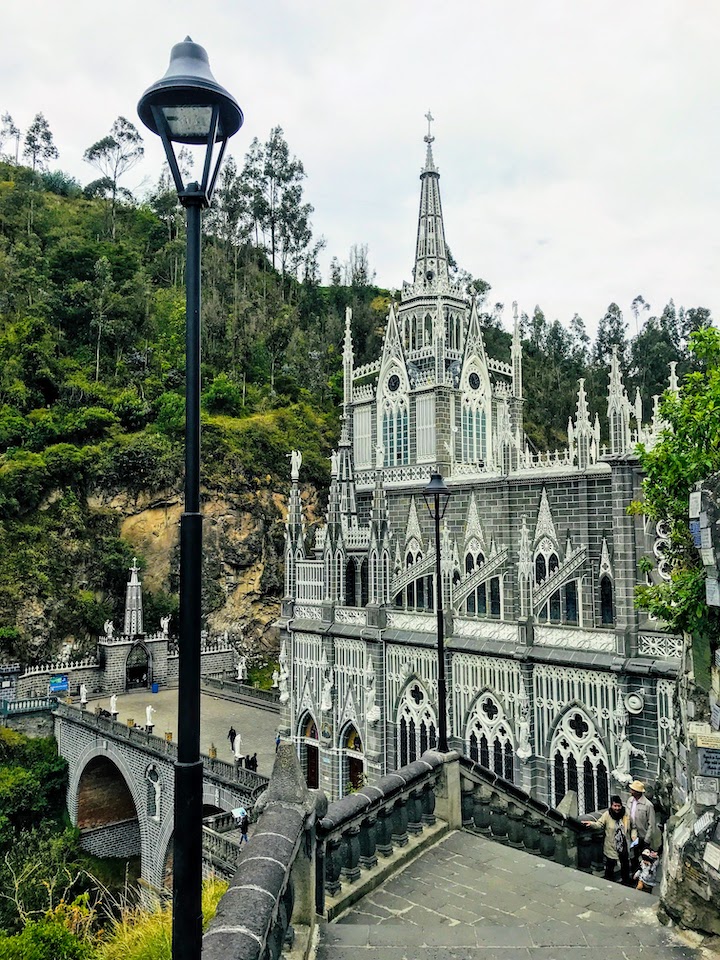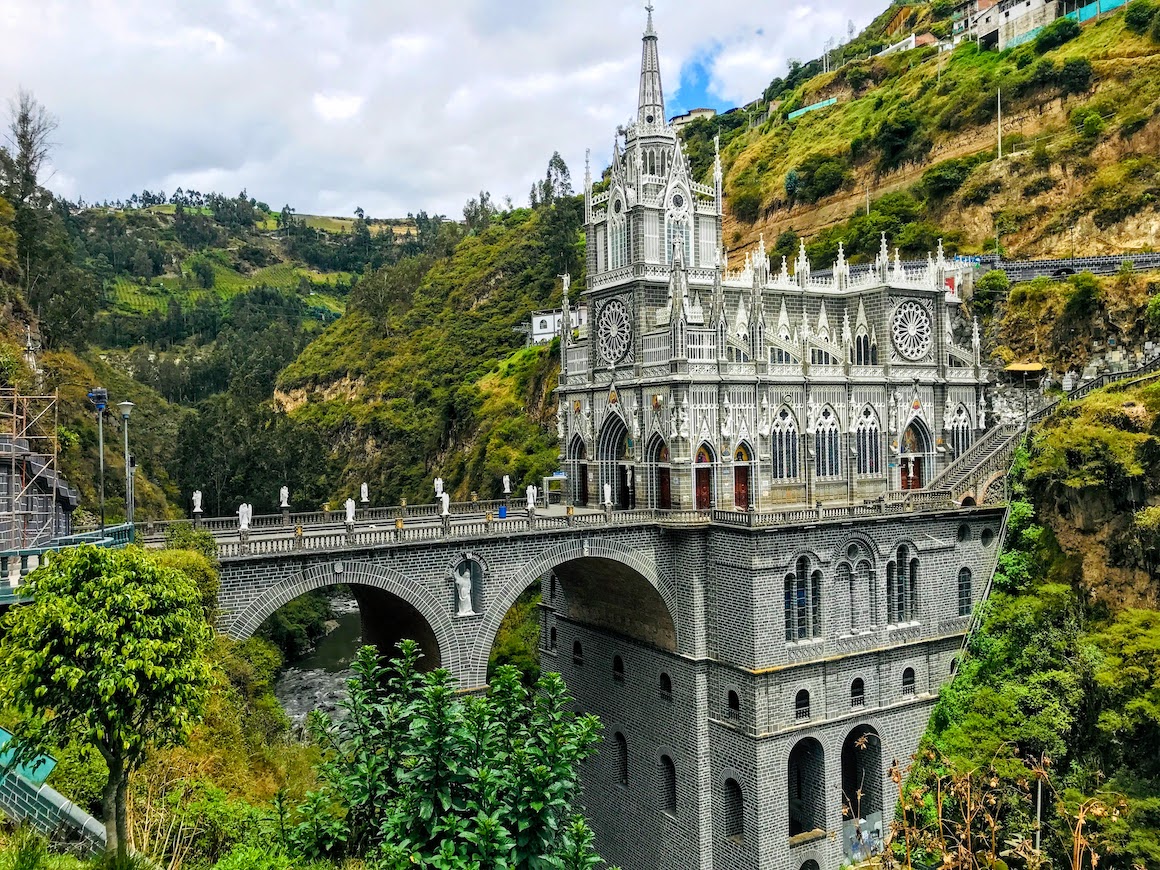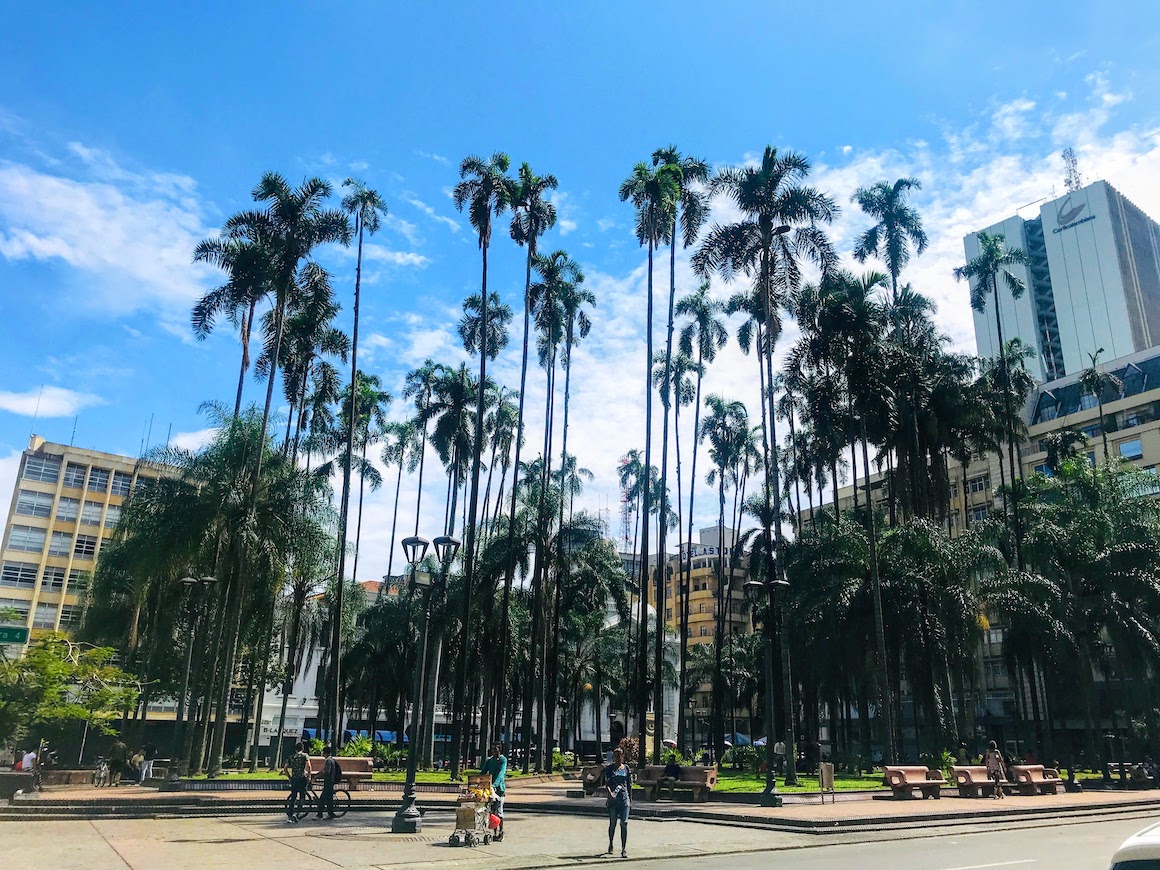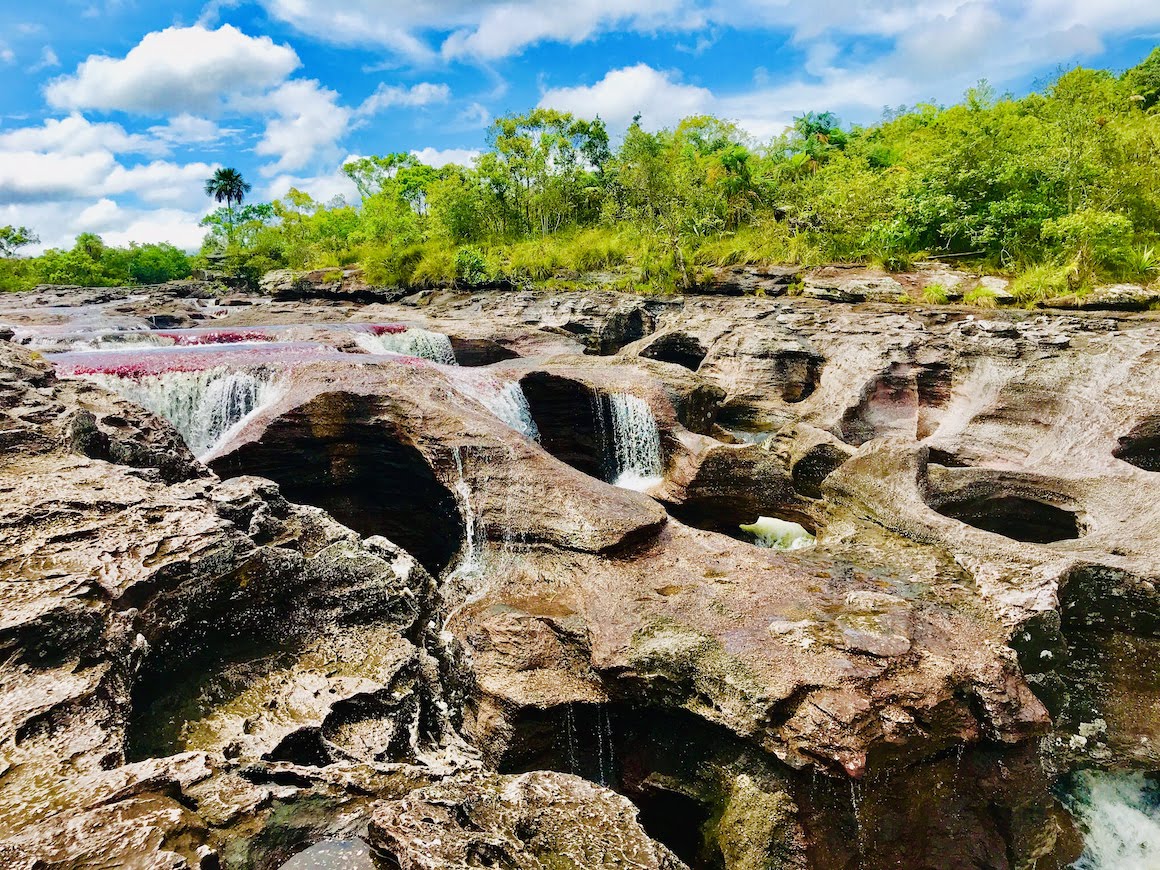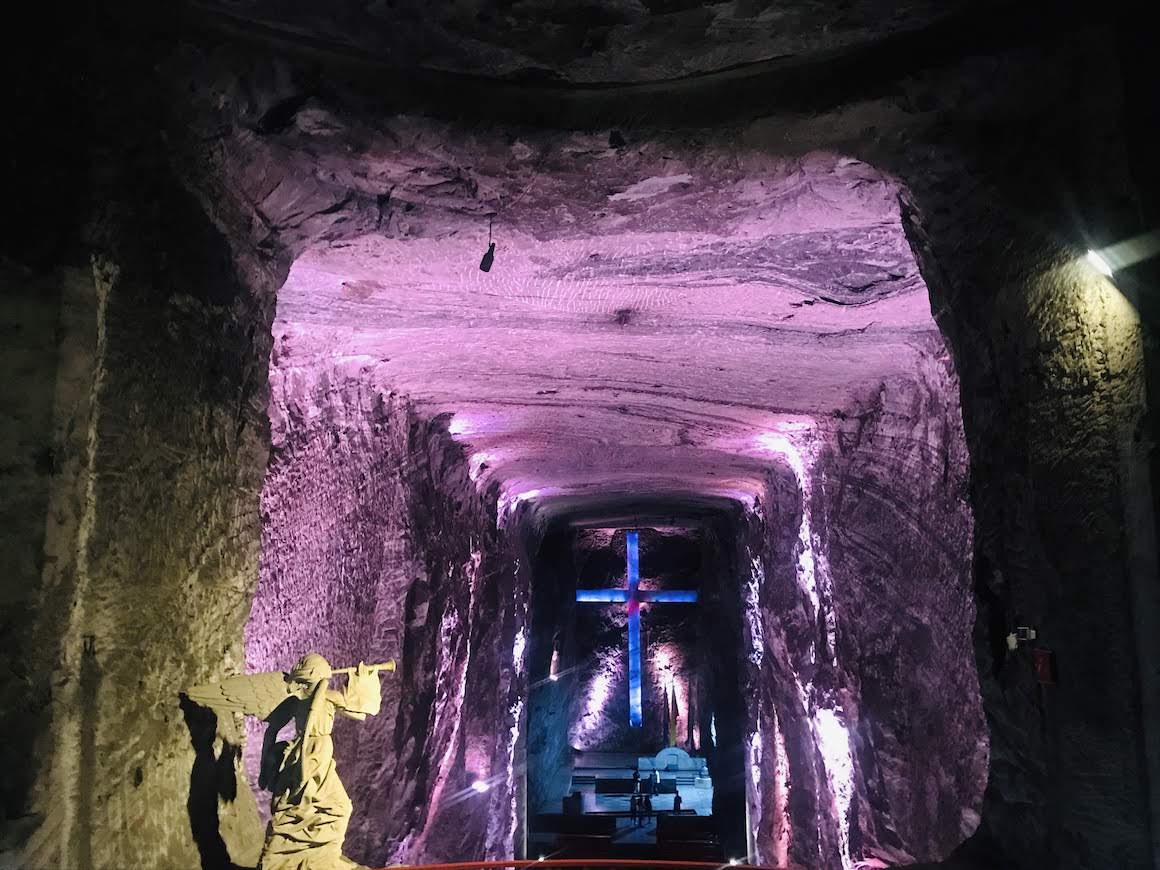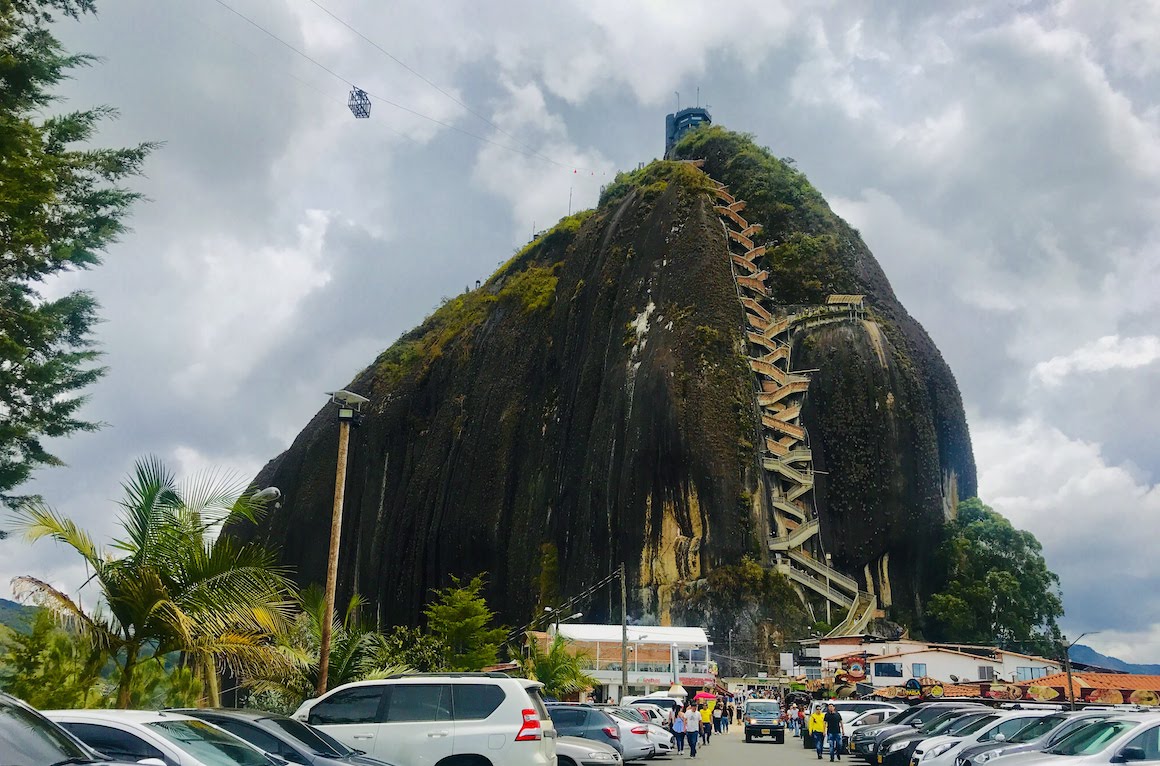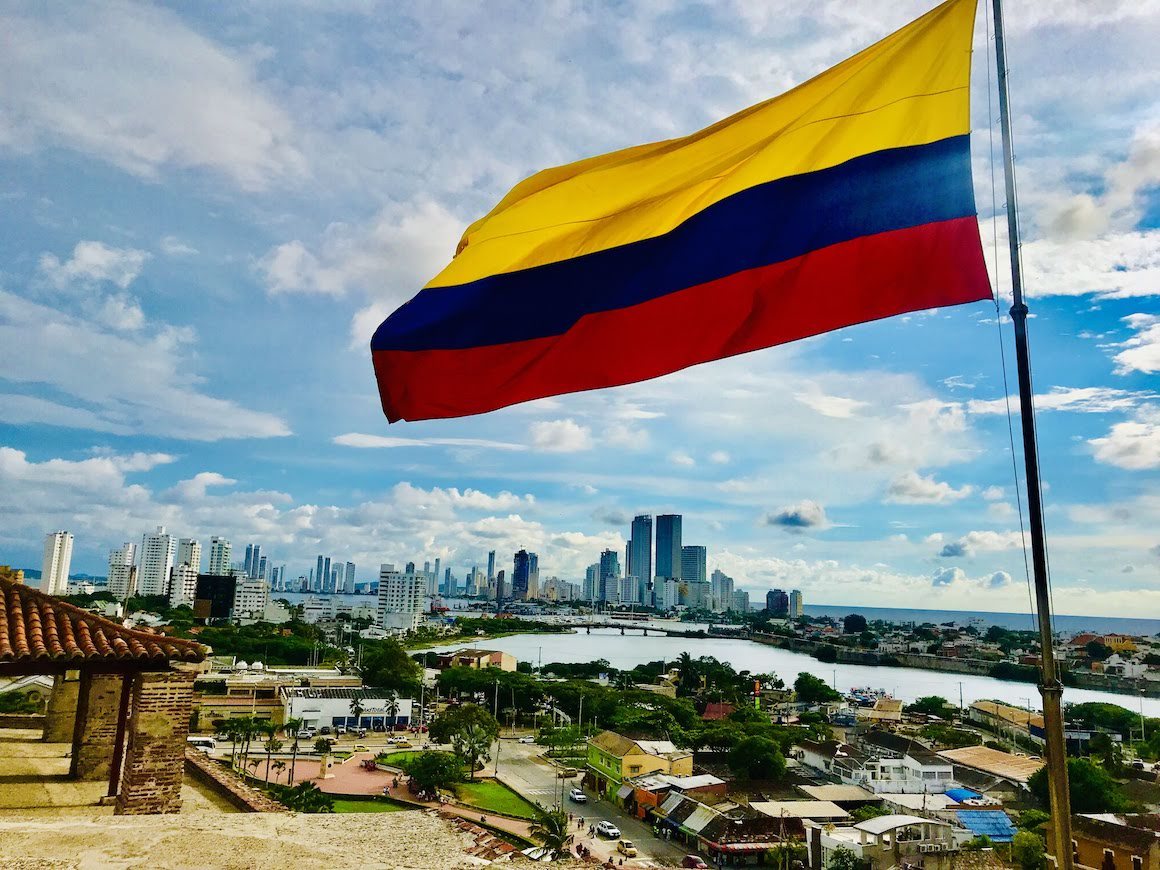Jump to
- Cartagena – 4 days/5 nights
- Medellin – 3 days/4 nights
- Free walking tour
- Visit the Museo Casa de la Memoria (the Memory museum)
- Day tour of Guatape
- Bogota – 5 days/6 nights
- Free walking tour
- Research and checked out the bus terminal
- Zipaquira Salt Mines
- Monserrate hill
- Relax and walk to La Candeleria
- Villavicencio – 1 night
- La Macarena – 2 nights
- Cali – 2 days/3 nights
- Ipiales – 1 day/2 nights
CARTAGENA
 We started our third South America trip with Cartagena. Just coming off a 10-day drive across America, I feel like this trip was our least planned trip. But after having travelled previously in South America, I wasn’t worried.
We started our third South America trip with Cartagena. Just coming off a 10-day drive across America, I feel like this trip was our least planned trip. But after having travelled previously in South America, I wasn’t worried.
Day 1:
Our flight arrived late at night in Cartagena, so the next morning we needed to start the day with a visit to the ATM and then some basic groceries like milk, coffee, etc. We also planned to get a prepaid SIM card, but the store was closed since it was Sunday. Because of these errands, we decided to take the 4.00 pm free walking tour. Freetourcartagena.com provides free walking tours in English and Spanish twice daily at 10 am and 4 pm. We started from our apartment around noon and although the building staff told us the best way to get to the old city was in a taxi or Uber, we saw a few buses close to our building, so we thought of giving it a try. We took the first bus that said it would go to ‘El Centro’ which was 5 minutes away and the fare was Colombian 2,000 (US$0.60) each.
The old historic center of Cartagena is enclosed by a wall and fortress and so is referred to as the ‘walled city’. It was originally a port city, and ever since the city was founded, it was easily attacked by many invaders coming to conquer it from across the seas. Therefore, they constructed a wall around the city, which took around 200 years to build. Although now the city has grown beyond the wall, the city center which is still within these walls has not lost its charm. The colonial style architecture with the beautiful balconies and colorful plants hanging from it and the quaint old world charm has given this city a UNESCO World Heritage Site label. And hence, all new construction or remodelling needs to be approved by the government. We had a couple of hours before the tour began, so we strolled the beautiful streets of the old city and looked for a place to eat. Due to the large influx of tourism, this city has attracted a large number of boutique shops, world class restaurants and bars which in turn has made it an expensive affair. The prices at most of the restaurants were on par with the ones you find in the US, so we looked around a bit and eventually found one that was filled with people and decided to give it a try. This restaurant called Espirito Santo had Colombian food at decent prices and looked like a favorite for both tourists and locals alike. I had grilled chicken with carbonara and Govi had a seafood dish which came with soup, salad (garden fresh or cooked potato salad), fries/fried plantain, coconut/white rice. 

After spending some time just walking along all the small streets, we eventually arrived at the meeting point for the tour. The guide started off by giving us a brief history of Cartagena and proceeded to show us the various points of interests such as the wall, Museo Naval Del Caribe, Plaza San Pedro Claver (who was the patron saint of the slaves), Plaza de los Coches, The Clock Tower, Plaza Santo Domingo, Plaza Simon Bolivar, and various monuments important to Cartagena. The tour ended by 6 pm at San Diego where we caught a beautiful sunset from the wall. The old city is very pretty and although it was a Sunday, it didn’t seem so crowded.  We were able to enjoy the beautiful city with its wooden balconies and flowering plants hanging from them, the elaborate ornate wooden doors with iron details and distinguishing knockers and the colorfully dressed Palenqueras in every corner selling fruits.
We were able to enjoy the beautiful city with its wooden balconies and flowering plants hanging from them, the elaborate ornate wooden doors with iron details and distinguishing knockers and the colorfully dressed Palenqueras in every corner selling fruits.  The guide also explained the meaning behind the various door knockers we saw all over the city which represented the class, social status and the profession of the owners living in the houses. The Palenqueras were originally enslaved women who were employed to sell fruits. This tradition has continued to this day and these women still make a living by dressing in these colorful outfits and carrying a basket of fruit on their heads. Ever since the influx of tourists here, if you want to take a picture with the Palenqueras, you have to buy some fruits or give them some money and only then will they pose for a picture. Unemployment is very high here and so tourism has become the main source of income, and hence you see the majority of locals cater to tourists by selling trinkets or souvenirs and hawkers swarming around trying to make a quick buck off of you. But in spite of this, Cartagena is a beautiful old city that has remained quite charming and is highly favored as a tourist dream spot.
The guide also explained the meaning behind the various door knockers we saw all over the city which represented the class, social status and the profession of the owners living in the houses. The Palenqueras were originally enslaved women who were employed to sell fruits. This tradition has continued to this day and these women still make a living by dressing in these colorful outfits and carrying a basket of fruit on their heads. Ever since the influx of tourists here, if you want to take a picture with the Palenqueras, you have to buy some fruits or give them some money and only then will they pose for a picture. Unemployment is very high here and so tourism has become the main source of income, and hence you see the majority of locals cater to tourists by selling trinkets or souvenirs and hawkers swarming around trying to make a quick buck off of you. But in spite of this, Cartagena is a beautiful old city that has remained quite charming and is highly favored as a tourist dream spot. 
We then proceeded to go to Plaza Bolívar as the guide had told us that people usually gather there at night and perform local dances. But we waited there for a while and nothing happened so we just hired a taxi and returned home.
Day 2:
 The next day started off with transport planning to our next destination Medellín. Govi was able to find a flight which was the same price as the bus so we tried to book that, but due to unstable internet, it didn’t go as planned. So we thought we would visit the Avianca office instead, which was a few blocks from our apartment after we picked up a couple of local SIM cards from the Claro office. When we arrived at the Avianca office, the lady informed us that we had to call customer service instead, so we went back to the apartment and completed the booking online. This pretty much took the entire morning and by the time we were all done it was 1.30 pm. So we first went to lunch at a restaurant close by and then we hired a taxi from there and went to the Castle San Felipe de Barajas. This is a fort that was built on top of a small hill just east of the old city to protect it from invaders both from land and sea. The entrance fee was Colombian 25,000 (US$ 7.25) each. Constructed in the year 1536 and later expanded in 1657, this is a very well preserved fortress with various tunnels, batteries and a garrison of 200 soldiers, which protected the city from several invasions.
The next day started off with transport planning to our next destination Medellín. Govi was able to find a flight which was the same price as the bus so we tried to book that, but due to unstable internet, it didn’t go as planned. So we thought we would visit the Avianca office instead, which was a few blocks from our apartment after we picked up a couple of local SIM cards from the Claro office. When we arrived at the Avianca office, the lady informed us that we had to call customer service instead, so we went back to the apartment and completed the booking online. This pretty much took the entire morning and by the time we were all done it was 1.30 pm. So we first went to lunch at a restaurant close by and then we hired a taxi from there and went to the Castle San Felipe de Barajas. This is a fort that was built on top of a small hill just east of the old city to protect it from invaders both from land and sea. The entrance fee was Colombian 25,000 (US$ 7.25) each. Constructed in the year 1536 and later expanded in 1657, this is a very well preserved fortress with various tunnels, batteries and a garrison of 200 soldiers, which protected the city from several invasions. 
We then walked 1.5 miles from here and reached the old city where we booked a couple of day tours for the next 2 days. We also waited for almost an hour till 7 pm at the clock tower plaza for the local dance performance but it started to rain and so we decided to return home. The taxi driver mentioned that the dances usually occur around 10 pm which was too late for us to stay behind as we had to get ready for our day trip the next morning.
Day 3:
 Today we booked a day trip to the Volcan El Totumo and a visit to the Mar Rosa Galerazamba. Price of the tour was Colombian $70,000 (US$ 20) per person and included lunch. The bus arrived at 8.45 am in front of our building to pick us up and spent the next hour picking up all the other tourists. Finally, we headed out and reached Galerazamba around 10.45 am. This is a coastal region where salt has been mined since the times when the indegenous folks lived here. During certain seasons (Mar-Apr & Aug-Sept), this part of the sea turns pink.. We walked along the sand path to reach the pink sea or Mar Rosa and from here we could enter the water a few feet in where they had placed some chairs so that we could take some aesthetic pictures. March-April is the best time to visit because of the intense pink color, but we visited during late September, so the sea was a lighter pink than at the peak, but still beautiful.
Today we booked a day trip to the Volcan El Totumo and a visit to the Mar Rosa Galerazamba. Price of the tour was Colombian $70,000 (US$ 20) per person and included lunch. The bus arrived at 8.45 am in front of our building to pick us up and spent the next hour picking up all the other tourists. Finally, we headed out and reached Galerazamba around 10.45 am. This is a coastal region where salt has been mined since the times when the indegenous folks lived here. During certain seasons (Mar-Apr & Aug-Sept), this part of the sea turns pink.. We walked along the sand path to reach the pink sea or Mar Rosa and from here we could enter the water a few feet in where they had placed some chairs so that we could take some aesthetic pictures. March-April is the best time to visit because of the intense pink color, but we visited during late September, so the sea was a lighter pink than at the peak, but still beautiful. 

We spent about 15 minutes taking pictures and then headed to our next stop – Volcan El Totumo. This is the smallest active volcano in Colombia and has become a popular attraction because of its healing mud bath. To get to the mud bath you have to climb a wooden staircase to the top of the volcano. In the crater will be a small pool that can accomodate 10-15 people who can bathe in the dense warm mud and get a massage. Govi did not want to get into the mud, but I went in for the experience.  So we had to leave all our belongings (including wallet) in the bus which was locked, and could take only a towel and a phone/camera to take pictures. As we climbed the wooden staircase, we left our footwear at the bottom (to be watched by a local).
So we had to leave all our belongings (including wallet) in the bus which was locked, and could take only a towel and a phone/camera to take pictures. As we climbed the wooden staircase, we left our footwear at the bottom (to be watched by a local).


I was in the pool for about 8-10 minutes and then went down another staircase to a lagoon close by. The price of the visit to the Volcano was included in the cost of the tour, but everyone who assisted us here had to be tipped Colombian $5,000 (US$1.50) each such as the person who watched our footwear, the one who offered the massage, the one who took photos while we were in the mud and the one who helped wash off the mud. We were here until 1.30 pm by which time everyone on the bus was done and then proceeded to a restaurant in a nearby village where we were served lunch (mainly fish, but we could also choose chicken, which I did). This restaurant was on a beach and after lunch, we were given about an hour to relax on the beach or swim. We departed by 3.30 pm and were back in our apartment an hour later.
All in all, I would recommend this tour because of the different experiences you would get with the mud bath and the pink colored sea. But I would suggest you go with an open mind and not expect too much out of it, especially the pink sea as the water color depends on the seasons. It is a great place to take some nice pictures. The volcanic mud bath however was a very nice experience for me, but it all depends on your interest and comfort.
Day 4:
 Today we had booked a tour to the Rosario Islands. The cost of the tour was Colombian $70,000 (US$ 20) per person and included lunch. We were picked up in front of our building at 8.15 am and after a slight hiccup with a flat tire and switching vans, we reached Playa Blanca around 10.15 am. We were taken to the beach and assigned a pair of lounge chairs and an umbrella and were told later that we would be going in a boat to the island shortly, but these seats will be reserved for us until we return and lunch will be served there. The cost for the chairs and umbrella was Colombian $70,000 but after negotiating, he brought it down to Colombian $40,000 (US $12 approx).
Today we had booked a tour to the Rosario Islands. The cost of the tour was Colombian $70,000 (US$ 20) per person and included lunch. We were picked up in front of our building at 8.15 am and after a slight hiccup with a flat tire and switching vans, we reached Playa Blanca around 10.15 am. We were taken to the beach and assigned a pair of lounge chairs and an umbrella and were told later that we would be going in a boat to the island shortly, but these seats will be reserved for us until we return and lunch will be served there. The cost for the chairs and umbrella was Colombian $70,000 but after negotiating, he brought it down to Colombian $40,000 (US $12 approx).
In a half hour, we were off on a speed boat to the Rosario Islands, which is a cluster of 21 islands. Here we could snorkel or we could visit some of the other islands. Since we had brought our snorkel gear, we opted to go snorkelling. Even though we had our own equipment, we had to go in a group so the cost for the guide and a person to watch our luggage was Colombian $35,000 (US$10) each. We snorkelled for almost an hour and got to see tons of fish. Among all the places we have snorkeled, I think this is where we saw the most number and the most varieties of fish. The guide also fed some bread to the fish so that they would swim up to us. We almost went about 300 feet away and got onto the boat in the middle of the sea instead of swimming back. I would recommend anyone who is interested in snorkelling to definitely do this, you will not be disappointed. 
We then made our way back to Playa Blanca and were served lunch. We had a good hour to relax on the beach and enjoy swimming in the warm Caribbean waters. Playa Blanca is one of the most beautiful beaches of Colombia and known for its pristine white sand and clean coastline. Other than the hawkers bothering you to buy trinkets, drinks, fruits, or offering massages every few seconds, it’s a very nice place to visit.
We returned to our van by 3.30 pm and reached home in 2 hours after a satisfying trip to both places. The next day, we bid goodbye to Cartagena and made our way to Medellín.
MEDELLÍN
Medellin, located in the Aburra Valley, a central region of the Andes mountains, is the second largest city in Colombia after Bogota. Until recently, this city was considered the most dangerous city to live in due to the violence propagated by the drug cartels. But now, the city is a lot safer and very tourist friendly. The locals here are very proud of their city and of Colombia and it is apparent how far they have come in making this a world class city.
We stayed in the Laureles Neighborhood which is a safe and hip place to stay. Just a few yards from our building was Carrera 70, a very famous street filled with restaurants, bars, casinos, etc. Although we stayed on the 7th floor, the music from an all night karaoke bar was loud, but I guess that is part of the charm of a big city.
Day 1:
Most large cities in South America have free walking tours which we really like and which give us a good introduction to the city. Medellin also has several of them but we chose the historical downtown tour offered by Real City Tours who came highly rated by tripadvisor. Medellin is the first and only city in Colombia to have a fully integrated metro system with metro, trams, cable cars and buses all linked which can take you to any corner of the city. We took the metro which was located 4 blocks from our apartment to get to the meeting place for the tour.
Medellin, unlike the other cities in South America, did not face major conquests or wars at the hands of the Spaniards, but their recent history is riddled with war and violence. The oldest building here only dates back 100-125 years. The guide went on to explain how the Spaniards who came here did not find any gold and so they moved on to other parts of the country. The city later gained popularity by cultivating coffee and becoming a world leader in coffee production which brought this city and Colombia up to the forefront in trade and commerce.
Some of the interesting places we saw on our walking tour were:
- The old railway station

- The Alpujarra administrative center with the large sculpture called the “Monument to the Race” by Rodrigo Arenas Betancourt in honor of the history of Antioquia, the Mayoral offices, the Department of Justice and other government offices


- The square of lights

- The Palacio Nacional which was originally built as a government building now turned into a shopping center

- The Veracruz church

- The Botero Square with more that 20 of Fernando Botero’s sculptures



Rafael Uribe Uribe Palace of Culture

Rafael Uribe Uribe Palace of Culture
- The murals in Berrio park


Day 2:
The Museo Casa de la Memoria (the Memory museum) which is the only place that recounts the violent history of the city and the homage it pays to the victims.
Day 3:
 Today we took a day trip to the town of Guatape to visit El Penol. The cost of the tour was Colombian $79,000 (US$ 23) per person and included breakfast, lunch, a boat trip along the dam in El Penol, visit to the Rock of El Penol and visit to the town of Guatape. We were picked up at 8 am from our apartment and reached our first stop for breakfast at 9.30 am. This was a beautiful farm house with a little restaurant attached to it nestled among coffee plantations. The breakfast consists of arepas (a traditional Colombian pancake made from corn), scrambled eggs, bread and coffee/juice.
Today we took a day trip to the town of Guatape to visit El Penol. The cost of the tour was Colombian $79,000 (US$ 23) per person and included breakfast, lunch, a boat trip along the dam in El Penol, visit to the Rock of El Penol and visit to the town of Guatape. We were picked up at 8 am from our apartment and reached our first stop for breakfast at 9.30 am. This was a beautiful farm house with a little restaurant attached to it nestled among coffee plantations. The breakfast consists of arepas (a traditional Colombian pancake made from corn), scrambled eggs, bread and coffee/juice.
From here a short 10 minute drive brought us to the town of Penol. This town has an interesting history behind it. Originally a small farming village, in 1970 the government decided to build a hydroelectric power generator here and so they had to relocate the entire town to its current location on a higher ground. So in order to do so, they built an exact replica of the town and then the old town was destroyed and flooded by the dam.  The old town in its entirety lies beneath a large lake which is now a major source and supplier of electricity to Colombia and also a tourist attraction. We took a boat ride along the lake and saw the large cross that was laid on top of where the old church was. The only building that survived belonged to a wealthy doctor. Other than that, we also saw the home of a famous football player and one of Pablo Escobar’s homes along the banks of the lake. Escobar had a large house here which was bombed in 1993 and only the shell remains, but another structure which was his private casino is still intact, but empty. After the boat ride, we went to the replica church which was now located a few hundred meters from the docks. Along with the church there were a couple of souvenir shops and some cafes.
The old town in its entirety lies beneath a large lake which is now a major source and supplier of electricity to Colombia and also a tourist attraction. We took a boat ride along the lake and saw the large cross that was laid on top of where the old church was. The only building that survived belonged to a wealthy doctor. Other than that, we also saw the home of a famous football player and one of Pablo Escobar’s homes along the banks of the lake. Escobar had a large house here which was bombed in 1993 and only the shell remains, but another structure which was his private casino is still intact, but empty. After the boat ride, we went to the replica church which was now located a few hundred meters from the docks. Along with the church there were a couple of souvenir shops and some cafes.

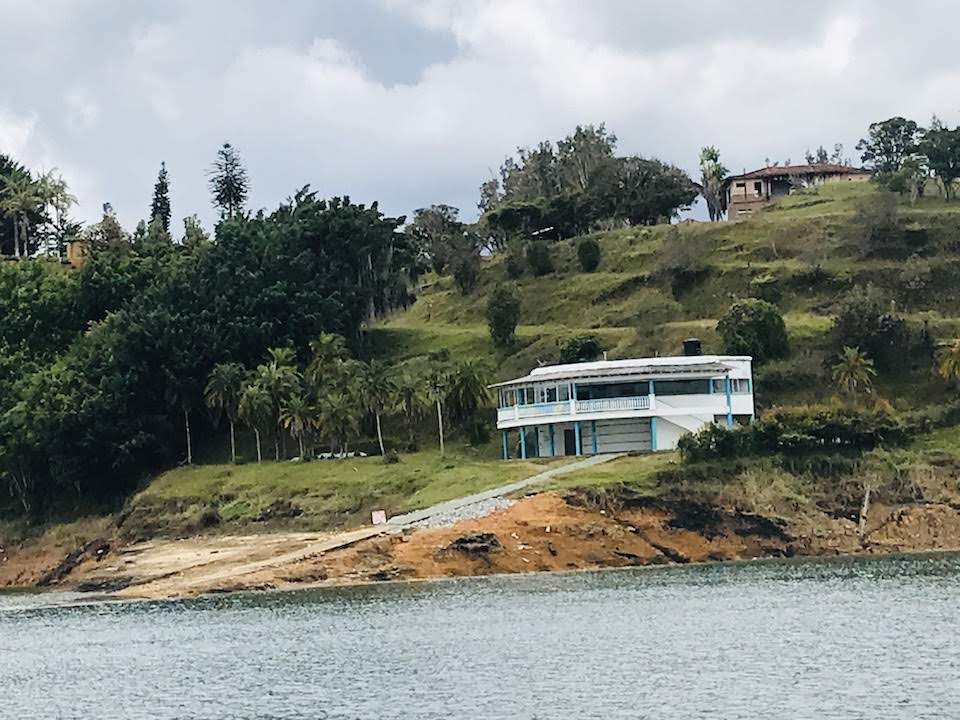


After the boat ride, we went to the replica church which was now located a few hundred meters from the docks. Along with the church there were a couple of souvenir shops and some cafes. 
 From here, we were driven to the rock La Piedra del Penol. This is a large granite rock that extends from the bedrock to a height of 200 meters and came into existence some 70 million years ago.
From here, we were driven to the rock La Piedra del Penol. This is a large granite rock that extends from the bedrock to a height of 200 meters and came into existence some 70 million years ago.  A staircase consisting of 750 steps has been built on one side of the rock and as you make your way to the top, you are rewarded with a spectacular panoramic view of the entire landscape, including the lake and the towns of El Penol and Guatape. Although it lies in the municipality of Guatapé, Antioquia, the town of El Penol, which borders Guatapé, has also historically claimed the rock as their own and both towns have been in constant conflict. Trying to claim the rock as their own, the people of Guatape wrote their town name on one side of the rock. In retaliation, the people of El Penol put an end to it. As a result, there is a large “G” and a partial “U” seen on the rock (see picture above). At the foot of the rock, there are various shops and restaurants. We were given about 1.5 hours to scale up and return down to our predetermined meeting point. Entrance fee is $18,000 COP (US$5.15) per person.
A staircase consisting of 750 steps has been built on one side of the rock and as you make your way to the top, you are rewarded with a spectacular panoramic view of the entire landscape, including the lake and the towns of El Penol and Guatape. Although it lies in the municipality of Guatapé, Antioquia, the town of El Penol, which borders Guatapé, has also historically claimed the rock as their own and both towns have been in constant conflict. Trying to claim the rock as their own, the people of Guatape wrote their town name on one side of the rock. In retaliation, the people of El Penol put an end to it. As a result, there is a large “G” and a partial “U” seen on the rock (see picture above). At the foot of the rock, there are various shops and restaurants. We were given about 1.5 hours to scale up and return down to our predetermined meeting point. Entrance fee is $18,000 COP (US$5.15) per person. 


 We took a good 25 minutes to make it to the top, taking breaks at every 50 or so steps. And once we reached the top, all our fatigue went away looking at the beautiful landscape that was before us. There was a large platform with railings at the edge, a small restaurant/coffee/snack bar and a souvenir shop. They have also built another viewing platform that you can access through a brick spiral staircase from where you get a fantastic panoramic view of the whole lake with all its twists and turns, the small town of Guatape and the mountains in the distance. After taking a good amount of pictures, we started to make our way down. The stairs to go down was a different one running just behind the ones we used on the way up.
We took a good 25 minutes to make it to the top, taking breaks at every 50 or so steps. And once we reached the top, all our fatigue went away looking at the beautiful landscape that was before us. There was a large platform with railings at the edge, a small restaurant/coffee/snack bar and a souvenir shop. They have also built another viewing platform that you can access through a brick spiral staircase from where you get a fantastic panoramic view of the whole lake with all its twists and turns, the small town of Guatape and the mountains in the distance. After taking a good amount of pictures, we started to make our way down. The stairs to go down was a different one running just behind the ones we used on the way up.  Interestingly, we could also see the old original wooden steps that were in existence before the current concrete ones were built in replacement. These were broken in several places and also looked very dangerous, and I’m sure, the majority of people would not have made it to the top looking at the rickety old steps. We were down in 10 minutes and went to the restaurant where the guide had instructed us to meet. Here we were served lunch which was a slightly scaled down version of the traditional Colombian dish called Bandeja Paisa which consists of rice, beans, salad, slice of avocado, some fried plantains, and your choice of meat.
Interestingly, we could also see the old original wooden steps that were in existence before the current concrete ones were built in replacement. These were broken in several places and also looked very dangerous, and I’m sure, the majority of people would not have made it to the top looking at the rickety old steps. We were down in 10 minutes and went to the restaurant where the guide had instructed us to meet. Here we were served lunch which was a slightly scaled down version of the traditional Colombian dish called Bandeja Paisa which consists of rice, beans, salad, slice of avocado, some fried plantains, and your choice of meat.
After lunch we got back on the bus and in a short distance reached the town of Guatape. This colorful town bordering the reservoir has become a tourist attraction thanks to the rock. The dam and electric power generation has largely impacted the town of Guatape and it is soon becoming a favorite tourist destination not only to the people of Medellin but also with foreigners. The unique thing about this town is each building has tiles along the facade’s lower walls (called Zocalo or foundation) in bright colors and 3D images. Many of the tiles relate to the products sold by the shops, or the beliefs of the residents. The small square and the surrounding area also have buildings and homes painted in bright colors and one of the squares has multiple steps painted and decorated with designs taken from the town’s foundation designs. We spent an hour over here looking at all of the colorful houses and the various beautiful Zocalo designs until it was time to get back on the bus and head back to Medellin.

A whimsical fountain

3D tiled wall decor


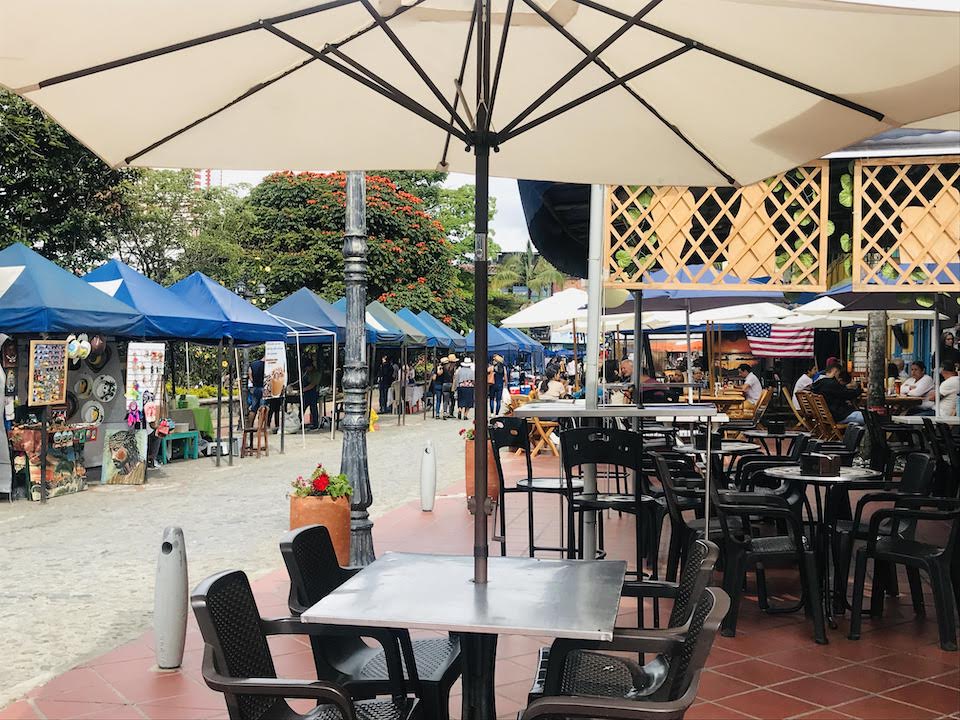
BOGOTA
The next city we went to in Colombia was Bogota, the capital. As soon as you come here, you know it is different from the other Colombian cities as it is markedly colder here, due to the altitude.
We stayed in the downtown neighborhood of La Candelaria. It was within walking distance to the meeting point for our free walking tour the next morning. This tour was offered by Beyond Colombia who also offers several other tours in addition to the regular introductory one such as War and Peace, Food tour, Graffiti tour, etc. The group met in front of the Museo del Oro (Museum of Gold) and from here we were taken on a tour starting with the history of the real “El Dorado” legend followed by visits to Plazoleta del Rosario, Plazoleta Chorro de Quevedo, various historic buildings and the large Simon Bolivar square. We also walked through the historic neighborhood which has colonial buildings and we saw some really great graffiti. Simon Bolivar square is flanked by several buildings such as the Catedral Primada de Colombia, the Congress, the Capitol building, the Palace of Justice, etc. The large square along with the pedestrian-only Carrera 7 which runs the distance from the Bolivar Square up to Calle 19 turns into a fair-like atmosphere during the weekends and holidays. We enjoyed walking along this stretch over the weekend although the festivities do not compare to the Sunday market of San Telmo in Buenos Aires or the weekend dances in the Plaza de Armas in Santiago.




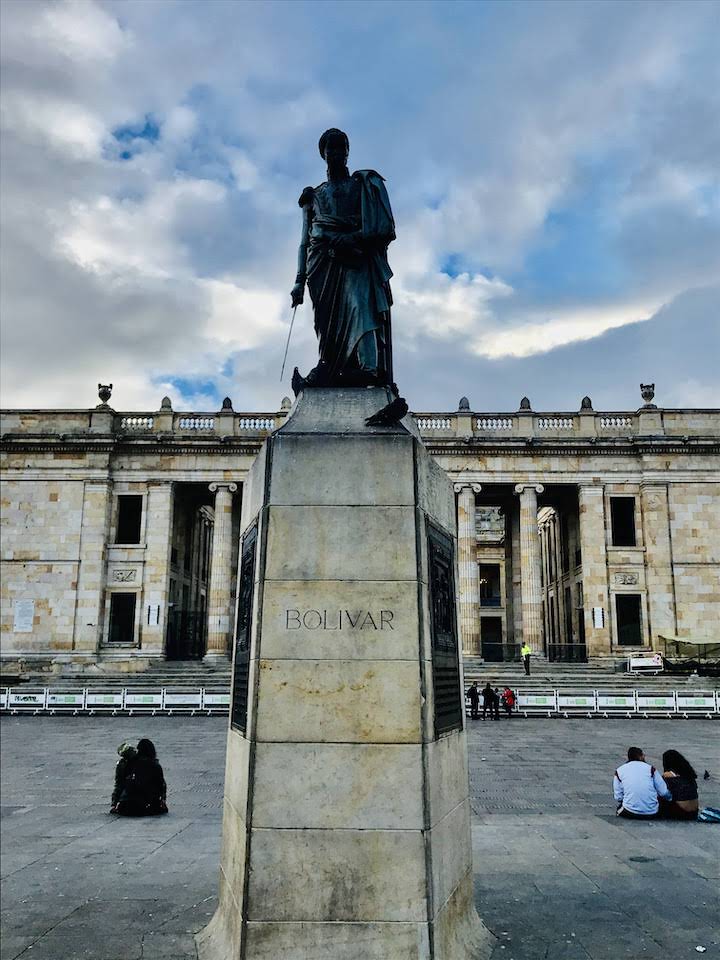
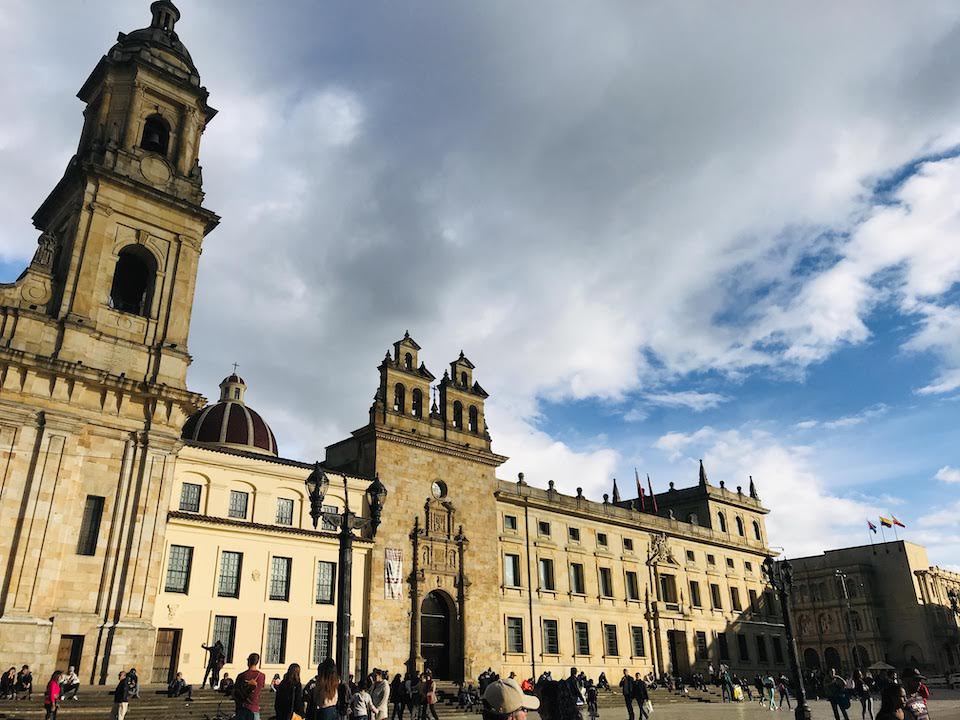


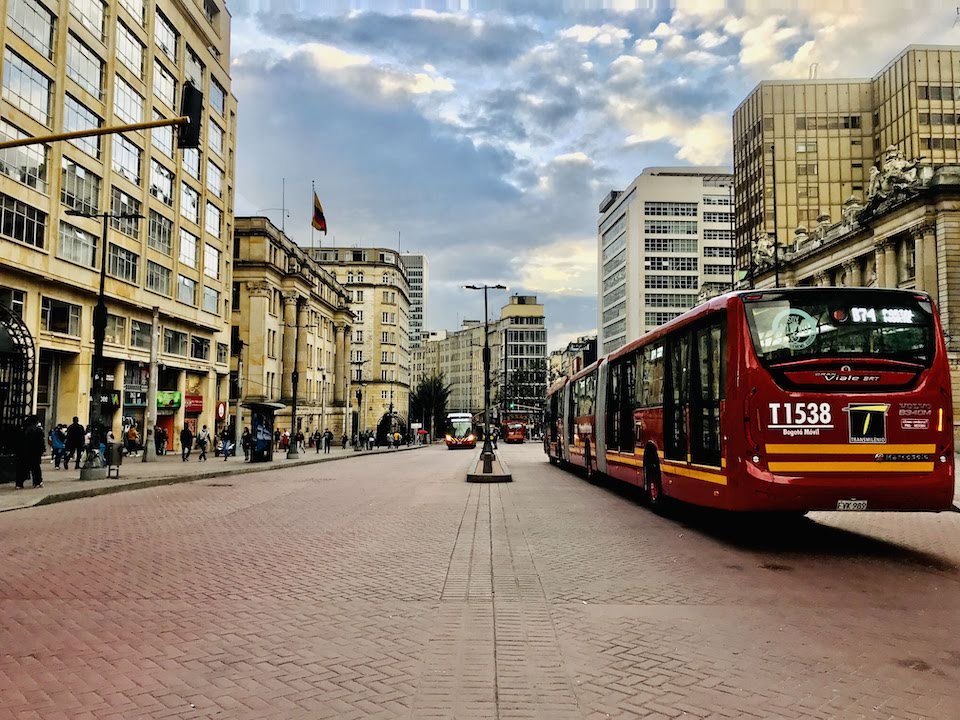
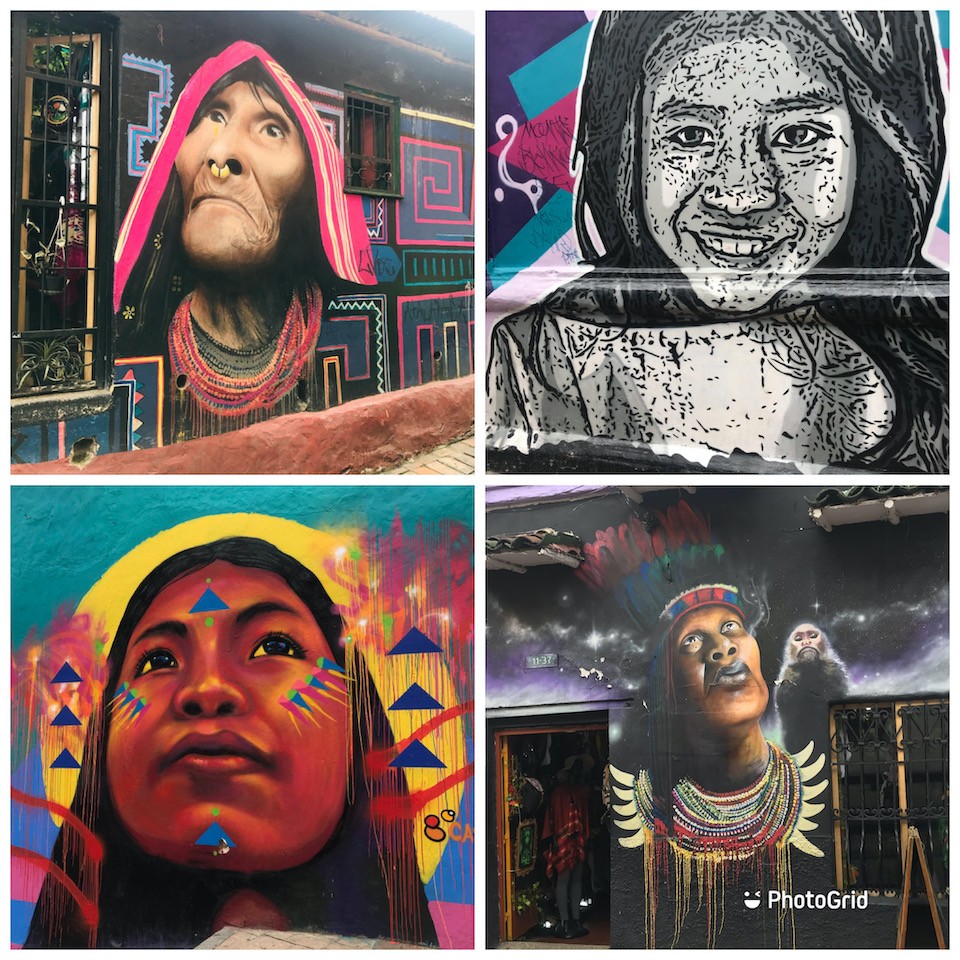
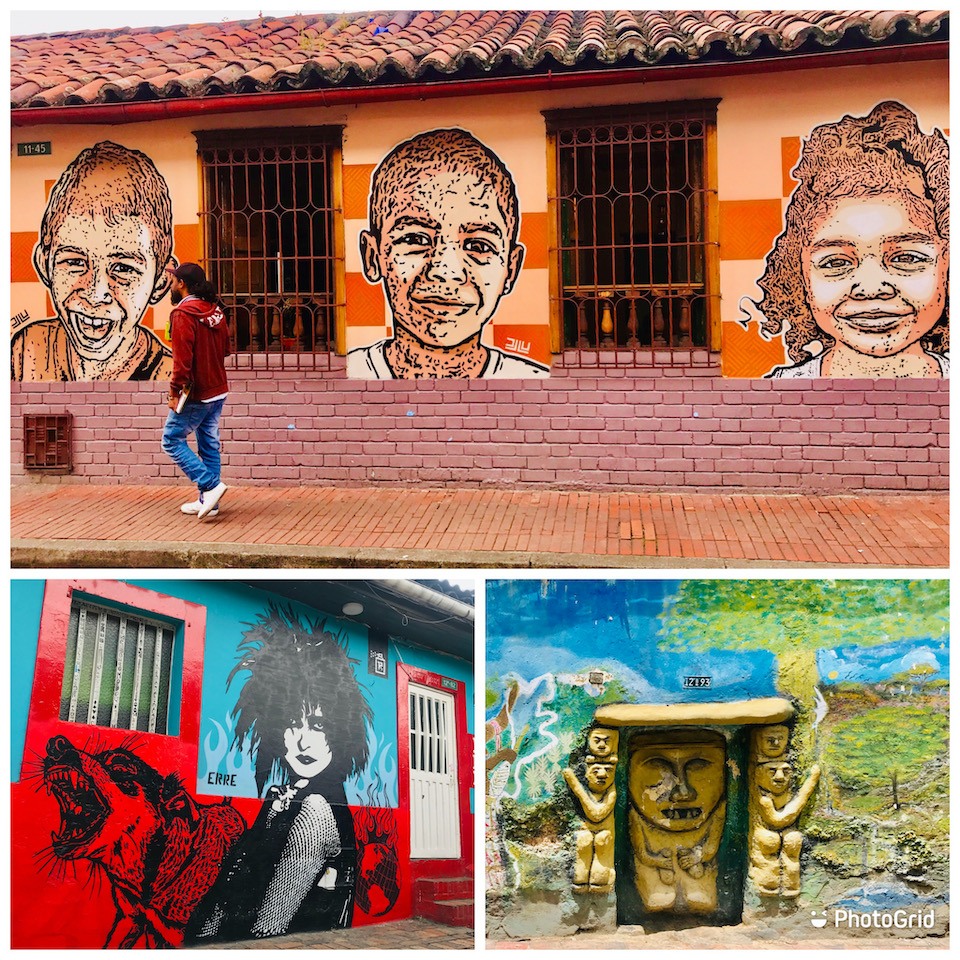

Transportation in Bogotá is quite convenient even though they do not have a metro system. There are the TransMilenio buses that run on a dedicated lane and cover most of the city and there are other city buses (SITP) which you can take to pretty much any part of town and both require a Tullave card that you can purchase and refill at any convenient store. The fare for one ride ranges from COP $1800-2300 (approx US$0.50-0.65).
Catedral de Sal
It is located in the town of Zipaquirá, about 25 miles north of Bogotá. As this is the biggest tourist attraction outside of Bogotá, there are several tourist companies that offer day tours, which would probably be the best way to visit ,but are also expensive. Instead, you could hire a taxi/Uber, but we took a public bus and it worked out a lot cheaper.
So here is what we did:
Make sure you have a Tullave card to be able to travel by bus. We went to the TransMilenio station at Calle 19 and Kr 4 and took the B74 to Portal Del Norte (takes about 25 minutes). After arriving at the Portal del Norte station, we walked across the street and found a person calling out for the bus to Zipaquirá. You can easily spot them as they constantly shout out “Zipa”. The bus fare was around COP $6000 per person (US $2) and it took an hour to reach Zipaquirá. The entrance of the cathedral was only 0.6 miles from where the bus dropped us off, on flat land, so we walked there. From the entrance of the cathedral, it is another 0.75 miles uphill. So depending on your stamina, you may choose to take a taxi directly to the cathedral.The entrance fee had several options, but the one we choose was for COP $69000 per person (US$ 20) that included a visit to the cathedral + audio guide, walking in the miners footsteps, visit to the museum, and bus tour of historic Zipaquirá.

Entrance tunnel
This cathedral was built by miners about 200 meters underground in the tunnels of the mines. The miners needed a place to pray and so they carved this cathedral in 1932 which was expanded and inaugurated in 1954. Due to structural problems, it was shut down and a new one was constructed 200 feet under the old cathedral and opened to the public in 1995.
 As we entered the tunnels, we saw 14 small chapels, each representing the various stages of Jesus Christ’s last journey. Each station has a cross and several kneeling platforms all carved into the halite structure. At the end is a dome overlooking the main nave. Descending from here we will come to the 3 naves (or halls) with the central main hall with a large cross carved onto the wall. All the crosses are illuminated with color changing light which gives it an eerie but ethereal feel. This is such a massive structure and the fact that it is all underground really makes it one of the most unique cathedrals in the world and warrants a place in every traveller’s bucket list.
As we entered the tunnels, we saw 14 small chapels, each representing the various stages of Jesus Christ’s last journey. Each station has a cross and several kneeling platforms all carved into the halite structure. At the end is a dome overlooking the main nave. Descending from here we will come to the 3 naves (or halls) with the central main hall with a large cross carved onto the wall. All the crosses are illuminated with color changing light which gives it an eerie but ethereal feel. This is such a massive structure and the fact that it is all underground really makes it one of the most unique cathedrals in the world and warrants a place in every traveller’s bucket list. 

As we exited the main hall there was a long tunnel with shops selling souvenirs, a movie hall that aired a small clip of the history in 3D format, some restaurants and a water mirror. Our ticket also included a journey into the mines which was a tour led by a Spanish speaking guide. This tour would have been a lot more interesting if we had an English speaking guide. Nevertheless, we went and could only decipher a little of what was explained. But we got to wear hard hats, walk in complete darkness through a tunnel and later dig the mine walls with a pick axe. After this tour, we exited the mines, had some snacks and then visited the Brine Museum (which was again explained by a Spanish speaking guide) and then took the city tour. This was a drive through the old town of Zipaquirá which was recorded as one of the earliest human settlements in the Americas. When the tour was over, we were dropped off at the town center. A short walk from here was the street we were dropped off at in the morning and again there were guys shouting “Portal”. We boarded one of those buses and within an hour reached Portal Del Norte and returned on the TransMilenia bus (J74 or any J line) to Bogotá.
Monserrate Hill
 This is a hill located close to downtown Bogotá and has a church at the peak. But the main draw is the panoramic view of the city of Bogotá. We took a local bus which picked us up across from our apartment and in 4 stops we arrived at the tram ticket office. From here you can either take the tram or the cable car and the fare is the same for both, COP $21000 RT per person (US$6). Once we bought the tickets (which was a long line and took us an hour), we had to wait another 20 minutes to get on the tram. The ride took less than 5 minutes and once we reached the peak we were treated to a spectacular view of the vast city. Along with the church, there were also 2 restaurants and a coffee shop. Mass was in progress at the church so we just stayed there a few minutes and headed out to the area where we could take some good shots of the view. After some coffee and hot chocolate we were back in line to ride the cable car on our way down. This also took almost an hour but the view from the cable car was beautiful and worth the wait.
This is a hill located close to downtown Bogotá and has a church at the peak. But the main draw is the panoramic view of the city of Bogotá. We took a local bus which picked us up across from our apartment and in 4 stops we arrived at the tram ticket office. From here you can either take the tram or the cable car and the fare is the same for both, COP $21000 RT per person (US$6). Once we bought the tickets (which was a long line and took us an hour), we had to wait another 20 minutes to get on the tram. The ride took less than 5 minutes and once we reached the peak we were treated to a spectacular view of the vast city. Along with the church, there were also 2 restaurants and a coffee shop. Mass was in progress at the church so we just stayed there a few minutes and headed out to the area where we could take some good shots of the view. After some coffee and hot chocolate we were back in line to ride the cable car on our way down. This also took almost an hour but the view from the cable car was beautiful and worth the wait. 



After spending 5 days in Bogota, we went on a side trip to La Macarena to visit the Caño Cristales, the beautiful rainbow river. Our 3 day/2night tour departed from Villavicencio, so we took a bus from Bogota to Villavicencio from where we travelled on a small charter plane to La Macarena. You can read all about this one-of-a-kind place and our tour here. After completing our visit, we returned by plane to Bogota, stayed the night in a hotel and flew to Cali the following day.
Cali
Cali really does not have much to offer for tourists other than it being called the Salsa Capital of the World. The only other draw would be for Narcos TV show fans as the entire 3rd season was based on the notorious Cali Cartel who were based here. Some of the filming for the Netflix series was also done here. We came here mainly as a means to stop over on our way to Las Lajas and spent 3 nights here. The first day, we arrived in the afternoon by plane from Bogota. After checking into our apartment and lunch at a restaurant down the street, we picked up some groceries and got settled in for the night. The next day, our walking tour was scheduled for 2.30 pm at the La Merced Church.  Our guide showed us all the highlights of the historic old town such as:
Our guide showed us all the highlights of the historic old town such as:
- The Enrique Buenaventura Municipal Theater – previously called the Municipal Theater of Cali, a theater declared a national monument in 1982 located in the center of the city of Santiago de Cali.

- Iglesia de San Francisco – with the most beautiful mudejar tower in all of the Americas, it is completely made of bricks cut in a trapezoidal shape forming geometric designs similar to those found in the Giralda tower in Seville, Spain.

- Plazoleta de San Francisco – a plaza facing the church which is a favorite place for families to bring their children to feed and play with hundreds of pigeons that gather here.

- Catedral Metropolitana de San Pedro Apóstol – the main cathedral which is the seat of the archdiocese of Cali

- Plaza Calceido – this was the location where most of Narcos was filmed. It also has a lot of the wax palm trees which are the tallest trees in the world and are found in abundance in the Cocora Valley of Colombia.


- Iglesia la Ermita – this church was built in 1942 and resembles a miniature version of the Cathedral of Ulm in Germany. It is mostly visited by tourists now but since there was a wedding going on here as well, we did not go inside the church.

- The Promenade along the waterfront of the river Cali.
- Calle de la Escopeta – famous for graffiti art

The next day being a Sunday, we ventured out to check out the churches and the waterfront area that we had just walked by the previous day, but everything was closed. So we just took a long walk and returned home.
Las Lajas Sanctuary
A long, tiring 12 hour bus journey from Cali brings you to a small town named Ipiales, 10 minutes from the Ecuador border. Our next destination was Ecuador, so this stop worked out perfectly because it is not only the last town before the border but also the town closest to the famous Las Lajas Sanctuary. Nestled in the small village of Nariño, in the municipality of Ipiales, this church is built inside the canyon of the Guáitara River.
According to popular belief, the Virgin Mary appeared to a woman and her deaf-mute daughter in 1754 at exactly the same place where the church is now standing. Now a popular pilgrimage destination, this gothic revival structure was built between 1916 and 1954. It rises 100 meters from the bottom of the canyon and is connected to the opposite side of the canyon by a 50 meters tall bridge. It is a spectacular looking church and the view of it from the other side of the canyon where there is a walking path makes it all the more impressive. 
A 10 minute taxi ride from anywhere in Ipiales will bring you to the village of Nariño. The taxi will drop you off at the main road. There is a nice stone walkway going downhill to the church with benches every few feet to help people on their way up after visiting the church. 
 As you walk along this path, you can see the waterfall on the opposite side of the canyon which can also be reached as you cross the bridge and walk along on the opposite side to get a better view of the gorgeous church.
As you walk along this path, you can see the waterfall on the opposite side of the canyon which can also be reached as you cross the bridge and walk along on the opposite side to get a better view of the gorgeous church.
The inside of the church has beautiful stained glass windows adorning the walls. This is one of the hidden gems of Colombia which is not very well known but truly deserving of a visit and should be on every tourist’s list. 
